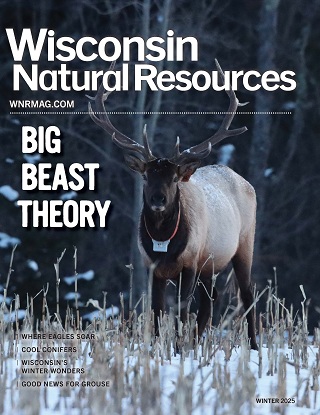Back in the day
FORWARD THINKING THEN BENEFITS BRULE RIVER NOW
Andrea Zani
 Indiana Gov. M. Clifford Townsend, left, takes part in a paddling trip on the Brule River in 1938, among the many dignitaries to visit the scenic northern Wisconsin river.
Indiana Gov. M. Clifford Townsend, left, takes part in a paddling trip on the Brule River in 1938, among the many dignitaries to visit the scenic northern Wisconsin river.© DNR FILES
The reflections of four fly-fishing anglers ("Life's better on the Brule") can be found in this issue of Wisconsin Natural Resources, recalling fond memories of trips to the Brule River. The ability to enjoy one of Wisconsin's true trout-fishing gems today is a credit to the visionary management of the Brule that began decades ago.
An example of that foresight can be found in the July 1950 issue of the Wisconsin Conservation Bulletin. A conservation warden in Superior writes to extoll the virtues of the Brule and notes that with careful planning, those shining characteristics will endure. Here are excerpts of that essay, with insight that seems just as relevant to the Brule nearly 70 years later.
The Brule Can Remain Great
By Wesley C. Newcomb
Conservation Warden, Superior
An officer who patrols our most famous trout stream points out that we can take a good harvest from the Brule if we supply the management that counts.
The Brule River in Douglas County is truly a great trout stream. It has been in years past, it is at present, and it will continue to be if just a few basic things are done to preserve the physical characteristics of the stream.
Many factors determine the suitability of a stream for trout. The temperature and chemistry of the water, together with the physical characteristics, which include food and cover, determine what trout will do in any stream.
The Brule has undergone many changes, the same as all other inland waters of this creation, and it will continue to change with time and tide as it continues to take the terrific beating of just being a river. The fact that people have used the Brule for travel, trapping, hunting, fishing, logging and living for these many years has made changes that have affected the trout population.
If the truth were known, we probably would learn that so much more spawn is lost through natural causes as to make the damage done by waders seem insignificant. Count the natural enemies of the trout and those which injure its natural habitat. Deer, beaver, mink, otter, muskrats, rabbits, northern pike, kingfishers, heron, mergansers and osprey are most destructive.
 Looking idyllic and serene along the Brule River, the Henry Clay Pierce estate, shown here in 1940, was the site of President Calvin Coolidge's "summer White House" in 1928.
Looking idyllic and serene along the Brule River, the Henry Clay Pierce estate, shown here in 1940, was the site of President Calvin Coolidge's "summer White House" in 1928.© DNR FILES
Another point to remember: We cannot be sure that a trout will be in our favorite hole, come next season, because there may be some change in the stream caused by high or low water, ice or windfall.
If the number of fishermen continues to increase, individual anglers may have to get enjoyment out of fishing as such — out of the sport. The Brule is a beautiful river, but there is a limit to its production.
Nevertheless, the Brule will remain a good trout stream if three important basic things are done to preserve the stream:
1. No logging or cutting of natural cover along the banks of the stream should be tolerated.
2. No roads or trails should be cut or graded down to the river because of the erosion hazard.
3. No pollution from habitation or otherwise should be allowed to dirty the banks or water.
Most people having summer homes and property on the Brule River have much at stake because they have a lot of money invested. In all but a very few spots on private lands, the river is kept clean and the scenic beauty is kept up. Property owners have always been good sports about allowing fishermen, and the fishermen should be very courteous.
In spite of some destruction, it is evident the Brule produces an excellent hatch of brook, brown and rainbow trout. With thousands of legal-sized trout being planted in the Brule River each year to bolster the natural reproduction, and the large run of all kinds of trout from Lake Superior each spring and fall, we have assurance the Brule will remain a favorite trout stream.
In short, if we do the basic things required to preserve the Brule, we can safely take a good trout harvest from it each year, with no fear that man will cause enough damage to loom up large among factors affecting this river.
Andrea Zani is managing editor of Wisconsin Natural Resources magazine.

